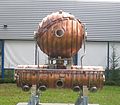Top Qs
Timeline
Chat
Perspective
Microcosm (CERN)
Museum at CERN in Meyrin (Switzerland) From Wikipedia, the free encyclopedia
Remove ads
Microcosm or CERN Museum was an interactive exhibition presenting the work of the CERN particle physics laboratory and its flagship accelerator the Large Hadron Collider (LHC). It first opened to the public in 1990 and closed permanently in September 2022, to be replaced by the Science Gateway in 2023.[1] The final version of the exhibition opened in January 2016,[2] developed by CERN in collaboration with Spanish design team Indissoluble.[3]

Remove ads
History
The project was approved by the CERN Directorate in February 1988. The initial construction, to a large extent completed in 1989, was financed through contributions from the Canton of Geneva, the Swiss Confederation, neighbouring France, banks, and industrial firms.[4][5]

Main exhibits
The exhibition displayed many real objects, taking visitors on a journey through CERN's key installations, from the hydrogen bottle, source of the protons that are injected into the LHC, through the first step in the accelerator chain, the linac, on to a model of a section of the Large Hadron Collider including elements from the superconducting magnets. Visitors could interact with the displays to try their hand at the controls of a particle accelerator – simulating the acceleration of protons in the LHC and bringing them into collision inside the experiments.
The exhibition contained a 1:1 scale model of a complete slice through the CMS experiment at the LHC. The computing section displayed some of the Oracle data tapes used to store the 30-40 petabytes of data produced yearly by the experiments, made available for analysis using the LHC Computing GRID. The annex to the exhibition contained other historical artifacts such as the central tracker from the UA1 detector, which ran at the Super Proton Synchrotron at CERN from 1981 to 1984, and helped discover the W and Z bosons.
Remove ads
Special projects
A project began in 2013 to preserve the original hardware and software associated with the birth of the World Wide Web. This effort coincided with the 20th anniversary of the research center giving the web to the world.[6]
Microcosm garden
The Microcosm garden is named Léon Van Hove Square in honour of CERN's Research Director-General from 1976 to 1980.[7] The garden features several large components of old CERN experiments.
- The garden view
- General view of the Detectors room
- Entrance to the exhibition
- Introduction to the particles room
- An RF cavity from the Large Electron–Positron Collider
- Initial stages of an old particle accelerator
- Particles room also features an interactive cloud chamber - device capable of displaying normally undetectable traces of radiation
- Measuring energy detector
- Detectors room
- DATA room
- LHC control room
- The central section of the UA1 experiment on display at the Microcosm museum
Remove ads
Location
Microcosm was located at CERN in the Canton of Geneva, Switzerland, near the town of Meyrin. Entrance was free, without reservation, open 6 days a week.[8]
See also
References
External links
Wikiwand - on
Seamless Wikipedia browsing. On steroids.
Remove ads













